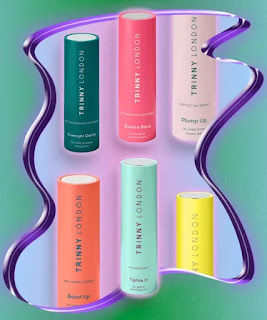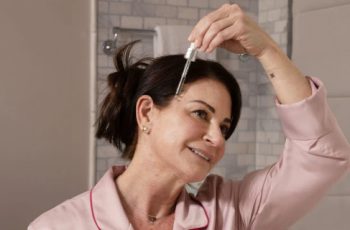
Does avoiding serums really improve your skin?
Gone are the days when a simple “cleanse, tone, and moisturize” routine was enough to take care of your skin. Today, social media trends, a variety of brands, and a better understanding of skin tissue have given us access to more products than we ever thought possible. But if you ask dermatologists, one type may be more popular than the others: targeted serums.
From hyaluronic acid to niacinamide, there are new serums to try almost every week. Don’t like retinol? You can always try a plant-based bakuchiol alternative. Do you think vitamin C is irritating? Ascorbyl glucoside may be your best choice. While all of these ingredients have their benefits, it’s clear that when it comes to serums, there’s a lot to choose from. That’s a good thing, of course. But how much is too much?
Have serums fallen out of favor?
As of this writing, searches for skin serums have dropped slightly according to Google Trends, and on TikTok, some beauty fans are questioning our obsession with skin serums. TikTok users share with their fans the products they ban from their daily lives in viral videos. “Goodnight, beast, but we can’t be beasts anymore,” is the title of a series of serums that users claim cause redness, rashes and irritation. “Unfortunate skincare purchases” are also a popular trend, with several best-selling serums becoming the stars of the show. In almost all of these viral clips, the serums in question contain active ingredients. Active ingredients are designed to address specific skin concerns. Some of the most popular ingredients include vitamin C, exfoliating acids (such as glycolic and lactic acids), niacinamide and retinol. The strength of these ingredients varies from product to product, but serums provide targeted skin support and tend to provide higher concentrations than most other products, such as cleansers and moisturizers. Many of the popular serums on TikTok are particularly concentrated, containing 30% vitamin C or 30% glycolic acid, for example.
Like TikTokers, dermatologists and skin experts have warned of the effects of overusing serums with strong active ingredients, claiming that patients themselves have suffered burns and rashes. Anna, a beauty doctor and skincare expert, explains that social media has greatly influenced public interest in skincare in recent years. She reveals that her patients experience a feeling of ‘FOMO’ (fear of missing out) when choosing a serum with a popular active ingredient. Consultant dermatologist Dr. Anjali Mahto agrees that influencer culture and influencer marketing perpetuate FOMO and drive many of the serum purchases she sees in her clinic.
Is layering serums bad for your skin?
The truth is that everyone’s skin is different. A strong exfoliating serum used to remove acne scars can severely irritate your face. The same goes for ingredients like retinol, which are known to cause irritation if not used correctly. However, one of the worst serum mistakes skincare experts see in clinic is applying too many layers. From hyperpigmentation to dull skin, you wouldn’t mind tackling all of your skin concerns in one go. But going all in can become a problem. “The ‘more is better’ ethos has risen, fuelled by social media like Instagram and TikTok, with people using multiple products and often adding unnecessary steps to their skincare routines,” says Dr. Mahto. “I’ve seen videos of people using up to 5-6 different ingredients in their nighttime skincare routine – but what skincare ingredients shouldn’t be mixed together?” Before we go on, a word of caution: At R29, we frequently cover skincare trends. If there’s a new, promising ingredient or serum, we’ll let you know. But everyone has different skin needs, and knowing whether a product is right for you before you buy (e.g. by contacting a skin expert, reading detailed reviews, or researching ingredient lists) is a good place to start.
Dr. Anna explains that your tolerance for a blend of active serums will depend on your individual skin type. However, she says that certain combinations are known to cause irritation – even when used alone, but especially when combined. For example, she advises against using retinoids with AHAs (alpha hydroxy acids, such as glycolic acid) or BHAs (beta hydroxy acids, such as salicylic acid). Other combinations that may cause irritation when applied directly on top of each other include: Vitamin C and the exfoliating acids listed above; benzoyl peroxide and vitamin C or an exfoliating acid; vitamin C and a retinoid; benzoyl peroxide and a retinoid.
Dr. Derrick Phillips, consultant dermatologist and spokesperson for the British Skin Foundation, explains that the right serum is a great addition to any skincare routine, especially if you’re looking to treat specific skin conditions like acne, breakouts or hyperpigmentation. But using more than two or three products or thick serums can clog your skin, which is bad news for those with issues like acne.
Dr Mahto explains that overuse can lead to other skin conditions, two of the most common of which are eczema and perioral dermatitis (an unpleasant red rash around the mouth). It’s such a common skincare concern that the hashtag
#periooraldermatitis has garnered 66.9 million views on TikTok and counting. In addition, Dr. Anna suffers from a weak skin barrier, symptoms of which include itching, flaking, redness, tightness and blotchiness. Ironically
There’s a reason skincare brands around the world are launching “barrier repair” moisturizers – serum overload means many of us have completely ruined our moisturizers.
Are serums still needed?
No one is suggesting you throw out your favorite serum. Depending on your skin concerns, the right product may work, and if it works for you, great. But Dr. Anna explains that, depending on time and budget, a serum is less necessary than your daily sunscreen and cleansing products. “I don’t think you should ever rule those out,” she says.
In fact, TikTok skincare enthusiasts are following suit. A quick search for “simple skincare routine” yields a ton of simple three-step routines that don’t require a complicated serum at all. Instead, TikTok users prefer
@stxph.h now to a simple cleanser, moisturizer, and sunscreen.
Experts agree that the best way to keep your skin healthy is to stick to the basics. “A simple skincare routine (one that doesn’t involve layering or using multiple active ingredients) is easier to stick to,” explains Dr.
Phillips. “You’re also less likely to get breakouts from congestion or redness on the skin and a combination of irritating ingredients.”
How to use a serum effectively without irritating your skin?
Serums may still be a popular purchase, but applying layers on your own is a risky endeavor. Against that backdrop, Dr. is careful not to use too many products at once. However, if you plan on using two or more serums in your routine, you may want to space them out. “For example, if you want to use vitamin C and vitamin A (retinol), use vitamin C in your morning routine [before sunscreen or moisturizer] and vitamin A in your evening routine [before moisturizer],” Dr. Mahto said.
Dr. Anna agrees. “If you have no particular concerns and want to protect your skin from environmental damage, I recommend a simple ABC approach. “A” stands for vitamin A (retinol), “C” stands for vitamin C, and “B” stands for sunscreen [or sunblock]. “Vitamin A should be used at night, vitamin C and sunscreen during the day.
Today, says Dr. Mahto, skincare formulas have become so advanced that brands often combine active ingredients in a single product so that they work in harmony. “Brands I particularly like are Paula’s Choice, Medik8 and Omorovicza,” she says. To make the most of your serum in this way, choose complementary ingredients, says Dr. Phillips. “A combination of retinol and niacinamide works well, with niacinamide’s anti-inflammatory properties helping to soothe the sensitivity caused by the retinol’s resurfacing effects. La Roche-Posay Retinol B3 is an anti-aging serum for sensitive skin (£38), which combines the two, as does the Youth to the People Retinol and Niacinamide Youth Serum (£59).
“A combination of niacinamide and vitamin C also works well,” says Dr. Phillips, “especially if the goal is to brighten the complexion.” ” R29 reviews Versed Stroke of Brilliance Brightening Serum, £18. Of course, Dr. Anna points out,
These blended serums should be used as directed. So make sure you read the instructions to avoid skin issues later.
Serums definitely have their place in skincare. But the consensus among experts and TikTok beauty fans proves that trying everything once and then overdoing it. If anything, the beauty industry’s reappraisal of serums is a positive. Both for your skin (especially if you’re experiencing some unexplained issues when using them) and, of course, your bank account balance.


